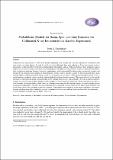Probabilistic Models for Beam, Spot, and Line Emission for Collimated X-ray Emission in the Karabut Experiment
Author(s)
Hagelstein, Peter L
DownloadJCMNS73.pdf (4.901Mb)
Terms of use
Metadata
Show full item recordAbstract
Collimated X-ray emission near 1.5 keV in the Karabut experiment is an anomaly that cannot be explained by conventional solid state, atomic, or nuclear physics. In order for the X-rays to be collimated, there must either be an X-ray laser present, or else a phased-array collimation effect produced by emitting dipoles that radiate in phase. Although there have been arguments made in support of an X-ray laser origin of the effect, from our perspective this approach suffers from an absence of a plausible mechanism, short excited-state electronic lifetimes, high power requirements, and an incompatibility between the experimental geometry and the need for an elongated laser medium for beam formation. In this work we consider a model for beam formation due to many
emitting dipoles randomly positioned within a circle on a mathematically flat surface. When the emitting dipole density is low, a speckle pattern is produced. Above a critical emitting dipole density beam formation occurs. The average intensity of the speckle and beam is estimated from simple statistical models at low and high dipole density, and combined to develop an empirical intensity estimate over the full range of dipole densities which compares well with numerical simulations. Beam formation occurs above a critical number of emitting dipoles, which allows us to develop an estimate for the minimum number of emitting dipoles present in the Karabut experiment. The effect of surface deformations is considered; constant offsets do not impact beam formation, and
locally linear offsets direct the beam slightly off of normal. Minor displacements quadratic in the surface coordinates can produce focusing and defocusing effects, leading to a natural explanation for intense spot and line formation observed in the experiments. Keywords: Beam formation; Collimated X-ray emission; Karabut experiment; Phase coherence; Up-conversion
Date issued
2017Department
Massachusetts Institute of Technology. Department of Electrical Engineering and Computer ScienceJournal
Journal of Condensed Matter Nuclear Science
Publisher
International Society of Condensed Matter Nuclear Scientists (ISCMNS)
Citation
Hagelstein, Peter L. "Probabilistic Models for Beam, Spot, and Line Emission for Collimated X-ray Emission in the Karabut Experiment." Journal of Condensed Matter Physics 22 (2017): 53-73 ©2017 ISCMNS
Version: Final published version
ISSN
2227-3123